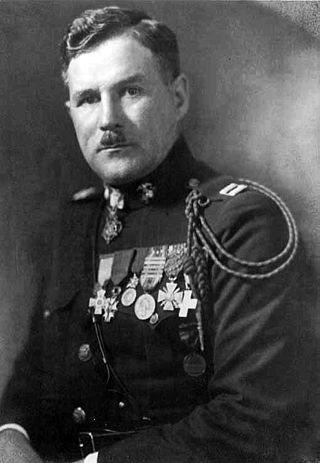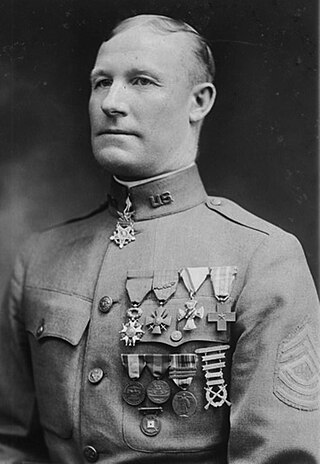Related Research Articles

The Croix de Guerre is a military decoration of France. It was first created in 1915 and consists of a square-cross medal on two crossed swords, hanging from a ribbon with various degree pins. The decoration was first awarded during World War I, again in World War II, and in other conflicts; the croix de guerre des théâtres d'opérations extérieures was established in 1921 for these. The Croix de Guerre was also commonly bestowed on foreign military forces allied to France.

Louis Cukela was a Croatian American United States Marine numbered among the nineteen two-time recipients of the Medal of Honor. Cukela was awarded the Medal by both the US Army and the US Navy for the same action during the Battle of Soissons in World War I. He was also awarded decorations from France, Italy, and Kingdom of Yugoslavia.

Major General Stuart Heintzelman was an American soldier. He was a grandson of Civil War general Samuel P. Heintzelman.

Julius Ochs Adler was an American publisher, journalist, and highly decorated United States Army officer with the rank of major general. He distinguished himself during World War I as Major and battalion commander in the 306th Infantry Regiment and received Distinguished Service Cross, the second highest decorations of the United States military for valor in combat.

Matt Louis Urban was a United States Army lieutenant colonel and one of the most decorated American soldiers of World War II. Urban performed valiantly in combat on many occasions despite being wounded in action several times. He received over a dozen personal decorations for combat, including seven Purple Hearts. In 1980, he received the Medal of Honor and three other U.S. decorations and one foreign decoration for his actions in France and Belgium in 1944.

Samuel Woodfill was a major in the United States Army. He was a veteran of the Philippine–American War, World War I, and World War II. Woodfill was one of the most celebrated American soldiers of the early 20th century. General John Pershing called Woodfill the most outstanding soldier in World War I. During an offensive in October 1918, he single-handedly neutralized three German machine gun emplacements while suffering under the effect of mustard gas, and was able to successfully lead his men safely back to the American lines without casualties. Woodfill was considered to be one of America's most decorated soldiers in World War I. He received the Medal of Honor, the French Légion d'honneur in the degree of Chevalier, the French Croix de guerre with bronze palm, the Montenegrin Order of Prince Danilo I in the degree of Knight and the Italian Croce al Merito di Guerra among other awards. So legendary was Woodfill's renown, that almost 11 years after the war ended, a Polish Army delegation presented him two medals. The presentation occurred during the 11th Annual National Convention of the American Legion held in Louisville, Kentucky from 30 September - 3 October 1929.

The fourragère is a military award, distinguishing military units as a whole, in the form of a braided cord. The award was first adopted by France, followed by other nations such as the Netherlands, Belgium, Portugal, and Luxembourg. Fourragères have been awarded to units of both national and foreign militaries, except for that of Luxembourg, which has not been awarded to any foreign units.

Earle Davis Gregory was an American soldier and World War I Medal of Honor recipient for his heroic actions in 1918 during the Meuse-Argonne Offensive in France.

Royal Cleaves Johnson was a U.S. Representative from South Dakota and a highly decorated veteran of World War I while he was still a member of Congress. Despite voting against United States declaration of war on Germany, he took a leave of absence from Congress to enlist. He became a highly decorated veteran receiving the Distinguished Service Cross from the United States government. He also received the War Cross 1914–1918 from the French government.
Ray Edison Porter was a U.S. Army Major General. In World War II he served on the Africa campaign, in the War Department, and then led the 75th Infantry Division. Dwight D. Eisenhower named him as one of fifty who took over the Army Service Forces' Project Planning Division, the Special Planning Division or SPD.

Daniel Bursk Strickler was the 19th lieutenant governor of Pennsylvania from 1947 to 1950, under Governor James Duff. He was also a career officer in the United States Army, with service on active duty, in the Army Reserve, and in the Pennsylvania Army National Guard, and he served as commander of the 28th Infantry Division.

Benjamin Kaufman was a First Sergeant in the U.S. Army during World War I. He received the Medal of Honor and the Croix de Guerre for bravery in action in the Argonne Forest, France on October 4, 1918.

Lloyd Milton Brett was a United States Army brigadier general who was a recipient of the Medal of Honor for valor in action on April 1, 1880, at O'Fallon's Creek, Montana. He graduated from West Point and served in numerous campaigns on the Western Frontier and later in World War I. He retired as a brigadier general in 1920.

Michael B. Ellis was a United States Army sergeant and a recipient of the United States military's highest decoration, the Medal of Honor, for his actions in World War I.

Harold Arthur Furlong was a United States Army First Lieutenant and a recipient of the United States military's highest decoration, the Medal of Honor, for his actions in France during World War I. He also received the Croix de guerre with palms and was made a Chevalier of the Legion of Honor.

George H. Mallon was an officer in the United States Army who received the Medal of Honor for his actions during World War I.

Orlando Henderson Petty was an American physician and naval officer. As a surgeon in the United States Naval Reserve, he received the Medal of Honor for his actions during World War I.

George Douglas Wahl was a highly decorated officer in the United States Army with the rank of Brigadier General. A veteran of both world wars, he distinguished himself as Artillery Commander and later as Assistant Division Commander, 79th Infantry Division during Normandy and Rhineland Campaigns.

Albert Walton Kenner was a decorated United States Army Medical Corps major general who served in World War I and World War II. During World War II, he was a Chief medical officer for Operation Torch and Operation Overlord.

Campbell King was an American infantry officer who served with the U.S. Army. He was the commandant at Fort Benning and is known for modernizing its training programs and infrastructure.
References
- 1 2 3 4 5 Fisher, W. Douglas and Joann H. Buckley. (2016). African American Doctors of World War I: The Lives of 104 Volunteers. Jefferson, North Carolina, McFarland & Company. ISBN 9781476663159
- ↑ "Valor awards for Thomas Edward Jones".
- ↑ Jones' military records